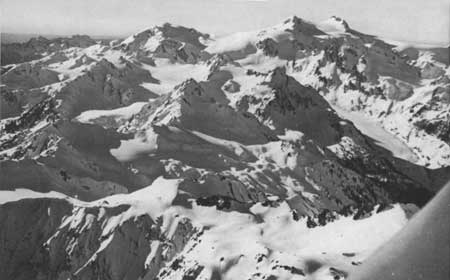|
OLYMPIC National Park |
 |
Glaciers Today
A glacier is a body of snow compacted into ice, large enough to move under its own weight. Valley glaciers start as snow fields in the mountains where snow accumulates layer by layer. The snow first becomes granular and finally changes to solid ice. Ice is a rather weak solid and will spread like batter on a griddle if there is sufficient pressure on it. When the ice is thick enough, its weight causes the bottom ice to spread out—to flow down the steepest slope. The ice is then a glacier.
The glaciers that remain in the Olympic Mountains today are small indeed compared to the extensive glaciers that formerly filled the valleys and sculptured the mountains. Many have disappeared completely, leaving only the shape of the land to testify that they once were here. However, more than 100 glaciers, having a collective area of at least 25 square miles, remain in the Olympic Mountains. Mount Olympus alone has 6 major glaciers, and the total area of permanent snow and ice on it is more than 10 square miles. Several other mountains also have glaciers, notably Mounts Anderson, Christie, Tom, and Carrie.
In addition, there are numerous snow patches that remain from one winter to the next but are not thick enough to form glaciers. Viewed from a high position, a panorama of north-facing slopes presents a profusion of snow and ice patches. The presence of so much snow and ice in mountains of modest height does not mean they are enveloped with inhospitable cold. It is due to the abundance of winter snow and considerable cloudy weather which retards its melting. Glaciers develop where snowfall exceeds the amount melted.
Like nearly all glaciers everywhere, those in the Olympic Mountains are dwindling. Each year they become shorter and thinner. Between 1938 and 1951, Blue Glacier, on the north side of Mount Olympus, melted back 776 feet. A comparison of old and recent photographs of Blue Glacier indicates that it may have shortened by as much as three-fourths of a mile since 1919. If excessive melting continues the glaciers will eventually disappear.
 PRECIPITATION ON MOUNT OLYMPUS MAY BE AS MUCH AS 250 INCHES SOME YEARS. —Photo by Richard Owens, Jr. |

|

|
| NPS History | History & Culture | National Park Service | Contact |
|
Last Modified: Sat, Nov 4 2006 10:00:00 pm PST |


